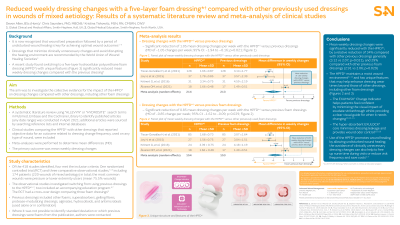Back

Evidence-Based Practice
(EBP-001) Reduced weekly dressing changes with a five-layer foam dressing* compared with other previously used dressings in wounds of mixed aetiology: Results of a systematic literature review and meta-analysis of clinical studies

Co-Author(s):
Chris Saunders, PhD MBChB – Evidence Analysis Senior Manager, Global Clinical and Medical Affairs
Introduction: Repeated clinically unnecessary wound disturbances can have a negative impact on healing. Advanced foam dressings, such as the five-layer hydrocellular polyurethane foam dressing (HPFD)*, have features designed to allow for maximised periods of undisturbed wound healing (UWH). The aim was to investigate how often dressing changes are required with the uniquely designed HPFD* compared with other dressings, including other foam dressings.
Methods: A systematic literature review was performed using Pubmed, Embase and the Cochrane Library to identify published articles. Randomized controlled trials (RCTs) and observational studies comparing the HPFD* with other dressings that reported objective data for an outcome related to dressing change frequency when used on any wound type were included. Meta-analyses were performed to determine mean differences (MD). The primary outcome was mean weekly dressing changes.
Results: Four studies were included; one RCT and three observational studies (in total 220 mixed aetiology wounds). The RCT had a cross-over design comparing three foam dressings. The observational studies switched from using previous dressings to the HPFD* and two also implemented a related education program. The HPFD* resulted in a statistically significant reduction in mean weekly changes compared with other previous foam dressings (from 2.91 to 2.06, MD: −0.85 [95% CI: −1.62 to −0.09]; p=0.029) or previous dressings generally (from 3.12 to 2.07, MD: −1.05 [95% CI: −1.94 to −0.16]; p=0.021), when used with or without an education program.
Discussion: The main finding is that the HPFD* (with or without an accompanying education program) results in fewer weekly dressing changes compared with other previous foam dressings or other previous dressings generally. The HPFD* has unique features that can help reduce clinically premature changes compared with other dressings, including other foam dressings. For example, the change indicator masks the visual impact of exudate strikethrough whilst providing a clear visual guide for when it needs changing. Use of the HPFD* can promote UWH and may help to release nurse time during visits or reduce visit frequency and save costs.
Trademarked Items: *ALLEVYN™ LIFE Foam Dressing
References:
Methods: A systematic literature review was performed using Pubmed, Embase and the Cochrane Library to identify published articles. Randomized controlled trials (RCTs) and observational studies comparing the HPFD* with other dressings that reported objective data for an outcome related to dressing change frequency when used on any wound type were included. Meta-analyses were performed to determine mean differences (MD). The primary outcome was mean weekly dressing changes.
Results: Four studies were included; one RCT and three observational studies (in total 220 mixed aetiology wounds). The RCT had a cross-over design comparing three foam dressings. The observational studies switched from using previous dressings to the HPFD* and two also implemented a related education program. The HPFD* resulted in a statistically significant reduction in mean weekly changes compared with other previous foam dressings (from 2.91 to 2.06, MD: −0.85 [95% CI: −1.62 to −0.09]; p=0.029) or previous dressings generally (from 3.12 to 2.07, MD: −1.05 [95% CI: −1.94 to −0.16]; p=0.021), when used with or without an education program.
Discussion: The main finding is that the HPFD* (with or without an accompanying education program) results in fewer weekly dressing changes compared with other previous foam dressings or other previous dressings generally. The HPFD* has unique features that can help reduce clinically premature changes compared with other dressings, including other foam dressings. For example, the change indicator masks the visual impact of exudate strikethrough whilst providing a clear visual guide for when it needs changing. Use of the HPFD* can promote UWH and may help to release nurse time during visits or reduce visit frequency and save costs.
Trademarked Items: *ALLEVYN™ LIFE Foam Dressing
References:

.png)